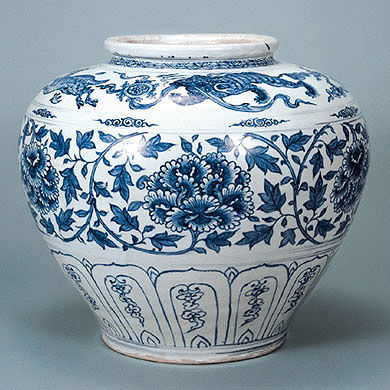The Vietnamese ceramics in the Asia Society's collection
The Vietnamese ceramics in the Asia Society's collection date from the 15th and 16th centuries, although the country first began production of glazed ceramics about two thousand years ago. Most of the collection's Vietnamese ceramics, which are stoneware, are painted with an underglaze blue. The Ming-period Chinese annexation of Vietnam from 1407 to 1428 and the imperial Chinese prohibition of the ceramic trade from 1436 to 1465 spurred the development of the Vietnamese ceramic industry in the 15th century. The introduction of the blue-and-white technology is the most noticeable effect of these two historical events. Originally used in Vietnam to replace the black underglaze iron decoration common on ceramics made during the 13th and 14th centuries, underglaze cobalt blue quickly became the most common color for painting Vietnamese ceramics.
Although the Chinese annexation of Vietnam may have provided the technology for blue-and-white wares, economic competition was an important stimulus in their development. By the 15th century, blue-and-white wares were the most popular ceramics in the world. Active markets for them existed in East Asia, throughout Southeast Asia, and in the Middle East. The Chinese prohibition of exporting ceramics for almost thirty years during this time of high demand provided an ideal opportunity for the Vietnamese ceramic industry to expand, and the Vietnamese reliance on Chinese prototypes was most likely a deliberate attempt to capitalize on the contemporary desire for Chinese-style wares.
Bowl. Vietnam. 15th century. Stoneware painted with underglaze cobalt blue. H. 2 5/8 in. (6.7 cm); D. 9 5/8 in. (24.4 cm). Mr. and Mrs. John D. Rockefeller 3rd Collection of Asian Art. 1979.097
Although the peony in the interior of this bowl is a Chinese motif, its placement as the central medallion is distinctly Vietnamese; peonies on Chinese ceramics are more likely to occupy the horizontal register on vases. The base of the bowl is covered with a chocolate-brown mixture of clay and water, or slip. The covering of the bottom of a ceramic piece in this fashion is found on wares from Vietnam and Thailand, but has no technical explanation and the purpose of this slip remains unclear. The choice may have reflected aesthetic preferences, or it may have served a more practical function. For example, the brown base may have served to differentiate vessels used in religious or other types of ceremonies from those used in more mundane settings or it may have been a potter's mark or possibly a counting symbol of some sort.
Storage Jar. Vietnam. 15th century. Stoneware painted with underglaze cobalt blue. H. 13 1/8 in. (33.3 cm); D. 14 in. (35.6 cm). Mr. and Mrs. John D. Rockefeller 3rd Collection of Asian Art. 1979.098
The lush rhythmic peony scroll encircling the body and the lions and deer on the shoulder of this Vietnamese storage jar are derived from Chinese prototypes but are not slavish copies. The spirited brushwork as well as the jar's heavier body differentiate the piece from its Chinese counterparts. Although the technique of painting with underglaze cobalt blue may have reached Vietnam from China before the 15th century, significant Chinese influence in Vietnamese ceramics came from the Ming-period Chinese annexation of Vietnam from 1407 to 1428 when the occupiers attempted to transform Vietnam into a Chinese province. Ironically, Vietnam's successful venture into the manufacture and export of trade ceramics, which was in direct competition with Chinese wares, was greatly aided by this experience as Vietnamese workshops became able to produce quality ceramics in the Chinese style. The Chinese court's prohibition of ceramic trade between 1436 and 1465 further spurred the development of the Vietnamese ceramic industry in the 15th century as the Vietnamese were able to step in to provide goods that were no longer available from China.
Duck-Shaped Vessel. Vietnam. 15th century. Stoneware painted with underglaze cobalt blue. H. 5 3/4 in. (14.6 cm); L. 8 in. (20.3 cm). Mr. and Mrs. John D. Rockefeller 3rd Collection of Asian Art. 1979.099
This charming duck-shaped vessel attests to the internationalism of Vietnamese ceramics during the 15th century. The motif of a single or a pair of mandarin ducks often symbolized marital bliss in China, although duck-shaped vessels were not common in Chinese ceramics. The impetus behind the development of this piece may have come from the Indonesian tradition of the kendi, a container originally used for pouring libations in Buddhist ceremonies. Kendi are generally distinguished by their spherical bodies and by the use of the neck as a handle as well as for filling the vessel. Vietnamese potters often modified the kendi by transforming the spout into the head of an animal or fish, and painting scales, fins, or feathers on the sides. Duck-shaped containers such as this one are often identified as water droppers because of their small spout openings. The four lugs on this vessel are unusual. Perhaps used to secure a cover or suspend the vessel, lugs are not found on kendi, suggesting that this vessel was intended for secular rather than ritual use.

/https%3A%2F%2Fprofilepics.canalblog.com%2Fprofilepics%2F1%2F0%2F100110.jpg)
/https%3A%2F%2Fstorage.canalblog.com%2F14%2F43%2F119491%2F72311865_o.jpg)
/https%3A%2F%2Fstorage.canalblog.com%2F02%2F88%2F119491%2F71838020_o.jpg)
/https%3A%2F%2Fstorage.canalblog.com%2F81%2F99%2F119491%2F64385784_o.jpg)
/https%3A%2F%2Fstorage.canalblog.com%2F71%2F64%2F119491%2F50041969_o.jpg)
/https%3A%2F%2Fassets.over-blog.com%2Ft%2Fcedistic%2Fcamera.png)





/https%3A%2F%2Fstorage.canalblog.com%2F05%2F64%2F119491%2F115101154_o.jpg)
/https%3A%2F%2Fstorage.canalblog.com%2F15%2F21%2F119491%2F115101105_o.jpg)
/https%3A%2F%2Fstorage.canalblog.com%2F42%2F30%2F119491%2F115084175_o.jpg)
/https%3A%2F%2Fstorage.canalblog.com%2F50%2F11%2F119491%2F115083706_o.jpg)